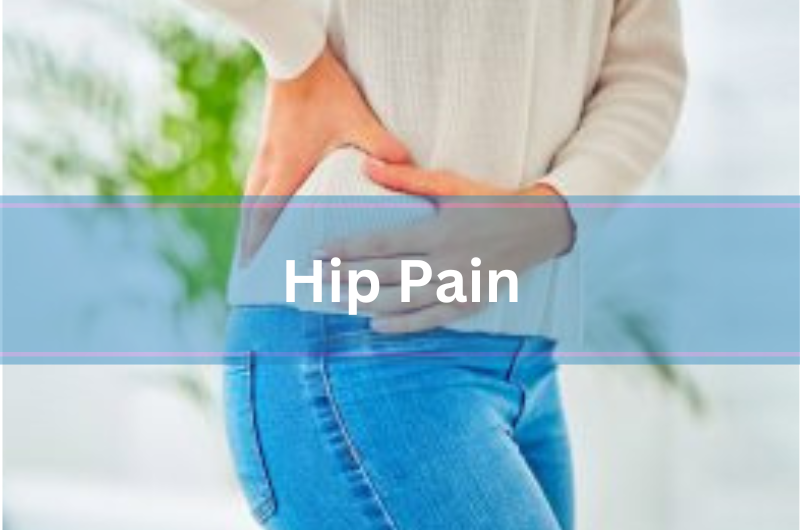Many people are affected by hip issues and pain especially in later stages of life. There are many causes, some serious and some less so. Hip pain can affect our quality of life especially if it affects our ability to walk.
Common Symptoms: pain or discomfort in the thigh, groin, buttocks or hip joint itself, inner or outer. Symptoms can depend on the cause and pain can also radiate from the back or groin to the hip. The pain can be aggravated by activity, especially if it is arthritis related. You may have limited range of motion in the hip and continued pain can cause a limp.
Anatomy: Bone: thefemur is a long bone into a ball and socket synovial joint. Cartilage: covering the ends of bones in joints, acts as a shock absorber, reducing friction when it is compressed. Labrum: ring of cartilage lining the rim of the hip socket (acetabulum) cushions the joint and helps stabilise the ball in the socket. Bursae: fluid filled sacs that cushion and ease the friction of soft tissues such as bones, muscles and tendons rubbing together. There are 2 bursae in each hip: trochanteric bursa at the outer side of the hip (greater trochanter) and iliopsoas bursa on the inner side. Ligaments: elastic tissue attaching bone to bone; iliofemoral, pubofemoral and ischiofemoral are strong and uniquely spiral, causing them to tighten when the joint is extended. Tendons: elastic tissue attaching muscle to bone. Muscles: to move the joint enabling walking, kicking, bending and swivelling the hips: iliopsoas, piriformis, quadriceps, hamstrings, adductors, abductors, gluteus maximus/medius/minimus, tensor fascia latae (ilio-tibial band), obturators, gemelli, pectineus, gracilis, sartorius. Neurovascular: femoral and gluteal arteries; sciatic, femoral and obturator nerves, which also supply the knee.
Serious Causes need medical diagnosis and/or treatment.
- Cancer: Bone tumours or ones that spread to the bone can cause pain in the hip as well as other areas.
- Hip fractures: falls are more likely to cause fractures in older people with weak and brittle bones and those with a history of osteoporosis, lack of calcium or vitamin D. Ballet dancers and marathon runners can develop stress fractures.
- Labral tear: can go unnoticed or give groin pain, clicking in the joint when moving or over time may damage the joint. Caused by falls, injuries and sports that involve twisting and hip rotation, such as hockey, soccer, ballet; also running.
- Osteo (Avascular)necrosis: necrosis (death) of bone tissue when blood flow to the hip is reduced by fracture/dislocation.
- Rheumatoid Arthritis: is a debilitating auto-immune condition that affects the joint linings, usually on both sides.
Less Serious Causes
- Bursitis: Inflamed bursae cause pain and can be caused by overuse or injury. The iliotibial band (ITB) along the outer side of the thigh from hip to knee, can rub against the trochanteric bursa when it is tight from hard use such as regular walking running or cycling. Other causes are hip injuries, muscle tears, hip surgery complications, gout, poor posture.
- Muscle or Tendon strain: from repetitive activities as well as poor postural and sitting habits; overuse can cause inflammation and pain affecting normal hip movement. Piriformis or psoas muscle tension can cause intense pain where they attach to the hip.
- Osteoarthritis: pain and swelling from inflammation and injury cause degeneration of the joint, breaking down cartilage.
- Tendonitis: Inflammation of the tendon caused by sudden injury or repetitive strain; also caused by infection.
Diagnosis: The doctor will examine the movement of your hip and may arrange extra tests such as X-ray, MRI or blood tests depending on the symptoms. Fractures and dislocations from trauma usually go directly to A&E by ambulance.
Treatment: Depends on the severity of symptoms or type of injury. Many injuries can be treated at home or get better with time. Avoid stressing the joint, use ice packs, rest and elevate the leg. Painkillers or anti-inflammatories may be advised as well as physical therapy. More serious injuries such as fracture, labral tear or joint degeneration may require surgery.
Exercises depends on the condition and capability of the individual; avoid pain with any exercise, we are looking for sweet relief! Some simple stretches to help ease hip pain at https://www.youtube.com/watch?v=z4LhTHLAiyo&t=2s
Prevention: Stretching, warming up and cooling down for sports and workouts; wearing the right equipment such as good trainers for walking/running. Be prepared for your sport with good training. Attend to minor injuries before they become major. Listen to your body!
Osteopathic/Manual Management: Take a detailed case history to understand the nature of the problem and surrounding issues. Examine the back, pelvis, thigh and hip and all surrounding tissues; muscles, ligaments, nerves, fascia, etc., for movement, strength and functionality and assess motor nerve pathways. Consider the effect of the injury/condition on the whole body. Perform orthopaedic and neurological tests. Treat to reduce muscle tension and pain and improve joint alignment and mobility; address any scar tissue in the area. Advice regarding specific strengthening and stretching exercises. Treatment may include manipulation, deep soft tissue massage, trigger point therapy, muscle energy techniques, fascial techniques, dry needling, etc.
We are happy to advise you on your health matters.
Lin Bridgeford DO KFRP MICAK MICRA FSCCO MSc
Registered Osteopath & Kinesiologist & Senior Yoga Teacher
Master Hypnosis and NLP Practitioner
Aether Bios Clinic
Saltdean
01273 309557 07710 227038
www.osteo-info.co.uk YouTube search Aether Bios OR Lin Bridgeford Instagram linbridgeford
https://linbridgeford.wordpress.com contains all my articles as blogs

